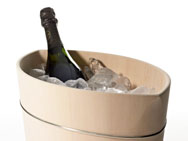LINK UP

- Field:
- Fine Carpentry
- Location:
- Kyoto-city, Kyoto
Nakagawa Woodcraft Studio
Based on 1000 Years of Tradition
In recent years, the production of wooden buckets has declined dramatically in Japan. In Kyoto, however, the skill of the surviving craftsmen continues to develop as they have shifted their focus from tableware and tea ceremony flower vases to various premium quality specialty products.
These champagne coolers are designed and created by Kyoto craft master Shuji Nakagawa, the third generation successor and proprietor of Nakagawa Woodcraft Studio. His father, Kiyotsugu Nakagawa, has been designated a Japanese Living National Treasure (Ningen Kokuho) for his renowned woodworking skills.
Currently only three wooden bucket craft workshops remain in Kyoto. When Nakagawa Woodcraft Studio began two generations ago, there were about 250.
Materials
Kiso Hinoki, which grows along the upper streams of the Kiso River, is recognized as the highest quality hinoki wood in Japan. Since some of the Kiso Hinoki forest areas were particularly well maintained by Owari Tokugawa*2, trees grown in these regions are referred to as Bishu Hinoki (bishu being an alternative name for owari).
To create our Champagne coolers, we only use the highest quality wood from carefully selected Bishu Hinoki trees that are more than 200 years old. Its gentle colors, fine grain and sensual texture affirm the superior quality of our products.
Hinoki boasts a refreshing forest fragrance which also makes it suitable for aromatherapy.
1・Ise Grand Shrine : Amaterasu Omikami, Japan’s Sun Goddess, central divinity, and ancestral deity of the Imperial Family, is enshrined in Ise Grand Shrine’s Naiku (inner shrine). Every 20 years all the main structures of Ise Grand Shrine are completely renewed and rebuilt consuming a great deal of hinoki wood.
2・Owari Tokugawa : One of the top three families of the Tokugawa Shogunate (feudal military government) during the Edo period (1603-1867)
200 Planes
This crafted bucket uses no metal nails. All joinery is performed with traditional woodworking techniques. After the tree has been felled and split, the wooden strips are left to rest for several years to several decades. Nakagawa then splits them into slats with a wedge and individually rounds the edges with a drawknife. After assembling the slats into the form of a bucket, Nakagawa planes the surface until it is rounded and smooth.
During the planing process, the craftsman is said to be so mentally focused that he sees each stroke from the perspective of the plane’s razor-sharp blade. This skill requires painstaking care and many years of practice.
Creation Process
Step 1
The wood is split into slats along the grain of its fibers and exposed to rain to prevent subsequent staining. These slates will become the sides of the buckets.
Step 2
A Draw knife is used to create the rounded shapes of each slat. The wall of the bucket incorporates about 20 of these wooden strips.
Step 3
A gauge, called 'shojiki"(honesty), is used to precisely measure the angles and curvature of the bucket's parts with zero tolerance for flaws.
Step 4
Small bamboo pegs are used to hold the slats together, creating the ring. next a plane is use to create the bucket's final shape. The split slates a re planed down by about a third.
Step 5
In the studio there are more than 200 planes. The smallest planes a thumb-sized.
Step 6
A shallow groove is routed out to hold the metallic hoop which is polished after insertion.


Kyoto SASHIMONO Champagne Cooler
Champagne Cooler Born from Japanese Woodwork Tradition
Japan enjoys an unparalleled history of exquisite wood culture. The allure of her sacred woodcraft creations are characterized by their perfectly straight grain and ivory-white color, the absence of any knots, the use of meticulous joinery rather than metal nails, and their lustrous natural finish. These are the distinguishing hallmarks of Japan’s temple and shrine architecture as well as her religious implements and tools used in refined practices such as the tea ceremony.
Kyoto Sashimono Master Creates and Elegant and Singulare Hand-planed Design
There are several varieties of Precious wood, including the Japanese Cypress. These Champagne coolers made of these sacred materials and superb joinery techniques, also exemplify Japan’s unique regard for wood’s sensuous beauty and meticulous artistic craftsmanship.
Born of Japan’s ancient woodcraft culture, Cypress Champagne coolers are lightweight, well insulated and condensation resistant, and combine stylish beauty with functional utility.